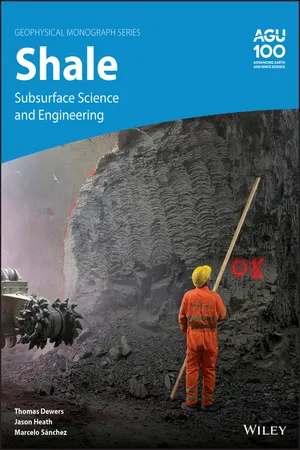
- English
- ePUB (mobile friendly)
- Available on iOS & Android
About This Book
Advances in theories, methods and applications for shale resource use
Shale is the dominant rock in the sedimentary record. It is also the subject of increased interest because of the growing contribution of shale oil and gas to energy supplies, as well as the potential use of shale formations for carbon dioxide sequestration and nuclear waste storage.
Shale: Subsurface Science and Engineering brings together geoscience and engineering to present the latest models, methods and applications for understanding and exploiting shale formations.
Volume highlights include:
- Review of current knowledge on shale geology
- Latest shale engineering methods such as horizontal drilling
- Reservoir management practices for optimized oil and gas field development
- Examples of economically and environmentally viable methods of hydrocarbon extraction from shale
- Discussion of issues relating to hydraulic fracking, carbon sequestration, and nuclear waste storage
Book Review: I. D. Sasowsky, University of Akron, Ohio, September 2020 issue of CHOICE, CHOICEconnect, A publication of the Association of College and Research Libraries, A division of the American Library Association, Connecticut, USA
Shale has a long history of use as construction fill and a ceramic precursor. In recent years, its potential as a petroleum reservoir has generated renewed interest and intense scientific investigation. Such work has been significantly aided by the development of instrumentation capable of examining and imaging these very fine-grained materials. This timely multliauthor volume brings together 15 studies covering many facets of the related science. The book is presented in two sections: an overview and a second section emphasizing unconventional oil and gas. Topics covered include shale chemistry, metals content, rock mechanics, borehole stability, modeling, and fluid flow, to name only a few. The introductory chapter (24 pages) is useful and extensively referenced. The lead chapter to the second half of the book, "Characterization of Unconventional Resource Shales, " provides a notably detailed analysis supporting a comprehensive production workflow. The book is richly illustrated in full color, featuring high-quality images, graphs, and charts. The extensive index provides depth of access to the volume. This work will be of special interest to a diverse group of investigators moving forward with understanding this fascinating group of rocks.
Summing Up: Recommended. Upper-division undergraduates through faculty and professionals.
Frequently asked questions
Information
Part I
Shale and Clay Overview
1
Mudrock Components and the Genesis of Bulk Rock Properties: Review of Current Advances and Challenges
ABSTRACT
Fine‐grained sediment (mud) and lithified equivalents (mudrock, mudstone, and shale) contain components similar to ones in coarser sedimentary materials, albeit of such small size that high‐resolution imaging is required to observe them. Such imaging reveals that fine‐grained sedimentary rocks display diversities of grains, pores, and diagenetic features that actually exceed the variations of components in common sandstones and limestones. Mudrock diversity reflects the extraordinary range of grain and pore sizes, which extend from detrital grains and authigenic crystals in the <1–100 μm fraction to the nanomaterials (crystals and pores) in the matrix surrounding the silt‐size fraction. Prediction of bulk‐property evolution in fine‐grained materials lags current process understanding in coarse materials but a view is emerging that while there are similarities, there are also contrasts between the responses of coarse and fine materials to changing conditions in the subsurface. Mechanical and chemical processes that operate on submicrometer pores and crystals very likely proceed to different limits, at different rates, and even by entirely different mechanisms than do comparable processes in coarser materials. This paper reviews current knowledge about mudrock components, and explores some of the gaps that exist in our understanding of microscale properties and processes in Earth's most abundant sedimentary material.
1.1. INTRODUCTION

Table of contents
- Cover
- Table of Contents
- CONTRIBUTORS
- PREFACE
- ACKNOWLEDGMENTS
- Part I: Shale and Clay Overview
- Part II: Unconventional Oil and Gas
- INDEX
- End User License Agreement